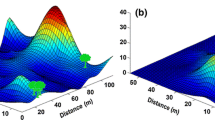Summary
Migrating birds that arrive at unknown stopover sites have to satisfy greater nutritive demands in restricted time and simultanously run a higher predation risk than residents which are familiar with the area. Foraging behaviour of resident and migrant frugivores feeding on fruits of Alder Buckthorn (Frangula alnus) was studied in Germany and Spain. German trees ripen their fruits during the autumn migration period, Spanish ones during the breeding and early postbreeding season. In both areas fruits were mainly eaten bySylvia warblers, Robin (Erithacus rubecula) and thrushes (Turdus sp.). At the stopover site birds spent less time in the tree, consumed more fruits per visit and therefore foraged more efficiently. In both areas birds clearly synchronized foraging bouts and formed intra- and interspecific assemblages, which were more frequent in migrants than in residents on the interspecific level. The influence of nutritive demands and predator avoidance upon the foraging behaviour and its consequences for seed dispersal are discussed.
Zusammenfassung
Zugvögel, die sich in unbekannten Rastgebieten aufhalten, müssen ihren erhöhten Nahrungsbedarf in begrenzter Zeit befriedigen und sind gleichzeitig einem höheren Prädationsrisiko ausgesetzt als residente Vögel, die das Gebiet kennen. Resultierende Unterschiede im Nahrungssuchverhalten von ziehenden und residenten fruchtfressenden Vögeln wurden anhand systematischer Beobachtungen an fruchtenden Faulbäumen (Frangula alnus) in Deutschland und Spanien untersucht. Deutsche Faulbäume fruchten während des Herbstzuges, spanische bereits während und kurz nach der Brutsaison. In beiden Gebieten wurden die Früchte vor allem von Grasmücken (Sylvia sp.), Rotkehlchen (Erithacus rubecula) und Drosseln (Turdus sp.) verzehrt. Im Durchzugsgebiet hielten sich Vögel zum Teil kürzer im Baum auf, verzehrten mehr Früchte pro Besuch und gingen damit effizienter vor. In beiden Gebieten bestand eine starke Tendenz zur Synchronisation von Baumbesuchen und zur intra- und interspezifischen Vergesellschaftung während der Nahrungssuche, die auf interspezifischem Niveau im Durchzugsgebiet noch ausgeprägter war als im Brutgebiet. Der Einfluß von Nahrungsbedarf und Prädationsvermeidung auf das Nahrungssuchverhalten sowie dessen Auswirkungen auf die Samenausbreitung der Pflanze werden diskutiert.
Similar content being viewed by others
Literatur
Alerstam, T. (1990): Bird migration. Cambridge.
Alerstam, T. & Lindström, Å. (1990): Optimal bird migration: the relative importance of time, energy, and safety. In: Gwinner, E. (Ed.): Bird migration: physiology and ecophysiology: 331–351. Berlin.
Bairlein, F. & Gwinner, E. (1994): Nutritional mechanisms and temporal control of migratory energy accumulation in birds. Annu. Rev. Nutr. 14: 187–215.
Bairlein, F. & Hampe, A. (1998): Von Vögeln und Früchten — Neues zu einem alten Thema. Ornithol. Mitt. 50: 205–217.
Berthold, P. (1976): Der SeidenschwanzBombycilla garrulus als frugivorer Nahrungsspezialist. Experientia 32: 1445.
Berthold, P. (1996): Control of bird migration. London.
Bibby, C. J., Burgess, N. D. & Hill, D. A. (1995): Methoden der Feldornithologie. Radebeul.
Boddy, M. (1991): Some aspects of frugivory by bird populations using coastal dune scrub in Lincolnshire. Bird Study 38: 188–199.
Brensing, D. (1977): Nahrungsökologische Untersuchungen an Zugvögeln in einem südwestdeutschen Durchzugsgebiet während des Wegzuges. Vogelwarte 29: 44–56.
Forsman, J. T., Mönkkönen, M., Inkeröinen, J. & Reunanen, P. (1998): Aggregate dispersion of birds after encountering a predator: experimental evidence. J. Avian Biol. 29: 44–48.
Glück, E. (1987): Benefits and costs of social foraging and optimal flock size in Goldfinches (Carduelis carduelis). Ethology 74: 65–79.
Glutz von Blotzheim, U. N. & Bauer, K. M. (1980–1997): Handbuch der Vögel Mitteleuropas. Vol. 9–14. Wiesbaden.
Hampe, A. & Bairlein, F. (1998): Was bietet der Faulbaum (Frangula alnus) Vögeln für die Ausbreitung seiner Früchte? J. Ornithol. 139: 230.
Hampe, A. & Bairlein, F. (1999): Starke phänotypische Differenzierungen in disjunkten Populationen des Faulbaums (Frangula alnus, Rhamnaceae): Resultat seiner postglazialen Wiederbesiedlung Mitteleuropas? Verh. Ges. Ökol. 29: 59–64.
Herrera, C. M. (1984): Adaptations to frugivory of Mediterranean avian seed dispersers. Ecology 65: 609–617.
Howe, H. F. (1979): Fear and frugivory. Am. Nat. 114: 925–931.
Ibarra Benlloch, P. (1993): Naturaleza y hombre en el sur del Campo de Gibraltar: Un análisis paisajístico integrado. Dissertation Universidad de Sevilla.
Jordano, P. & Herrera, C. M. (1981): The frugivorous diet of Blackcap populationsSylvia atricapilla wintering in Southern Spain. Ibis 123: 502–507.
Kollmann, J. (1997): Hypotheses on the regeneration niche of fleshy-fruited species in natural forest gaps and edges in central Europe. Verh. Ges. Ökol. 27: 85–91.
Kollmann, J. & Pirl, M. (1995): Spatial pattern of seed rain of fleshy-fruited plants in a scrubland-grassland transition. Acta Oecologica 16: 313–329.
Krebs, C. J. (1989): Ecological Methodology. New York.
Lima, S. L. & Dill, L. M. (1990): Behavioural decisions made under the risk of predation. Can. J. Zool. 68: 619–640.
Parrish, J. D. (1997): Patterns of frugivory and energetic condition in nearctic landbirds during autumn migration. Condor 99: 681–697.
Pratt, T. K. & Stiles, E. W. (1983): How long fruit-eating birds stay in the plants where they feed: implications for seed dispersal. Am. Nat. 122: 797–805.
Pulliam, H. R. (1973): On the advantages of flocking. J. Theor. Biol. 38: 419–422.
Roberts, G. (1996): Why individual vigilance declines as group size increases. Anim. Behav. 51: 1077–1086.
Schuster, L. (1930): Über die Beerennahrung der Vögel. J. Ornithol. 78: 273–301.
Snow, B. K. & Snow, D. W. (1988): Birds and berries. London.
Thomas, D. K. (1979): Figs as a food source of migrating garden warblers in southern Portugal. Bird Study 26: 187–191.
Thompson, J. N. & Willson, M. F. (1979): Evolution of temperate fruit/bird interactions: phenological strategies. Evolution 33: 973–982.
Turcek, F. J. (1961): Ökologische Beziehungen der Vögel und Gehölze. Bratislava.
van der Pijl, L. (1972): Principles of dispersal in higher plants. 2. Aufl. Berlin.
Willson, M. F. (1986): Avian frugivory and seed dispersal in eastern North America. Curr. Ornithol. 3: 223–279.
Ydenburg, R. C (1998): Behavioural decisions about foraging and predator avoidance. In: Dukas, R. (Ed.): Cognitive ecology: 343–378. Chicago.
Author information
Authors and Affiliations
Rights and permissions
About this article
Cite this article
Hampe, A., Bairlein, F. Nahrungssuche und Vergesellschaftung frugivorer Zug- und Brutvögel. J Ornithol 141, 300–308 (2000). https://doi.org/10.1007/BF02462239
Accepted:
Published:
Issue Date:
DOI: https://doi.org/10.1007/BF02462239




